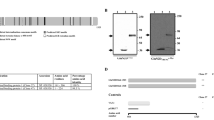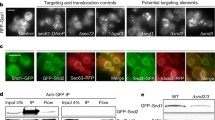Abstract
TIP-15 was previously identified as a cellular protein that can bind to the C-terminal end of the HTLV-1 Tax protein via its two PDZ domains. The sequence of the N-terminal part of TIP-15 is identical to that of the synaptic protein PSD-95. Both proteins are likely to be produced from the same gene by alternative splicing. Whereas expression of the PSD-95 mRNA was detected only with brain RNAs, that of TIP-15 was detected with RNAs from thymus, brain, skeletal muscle and Jurkat cells. The TIP-15 protein exhibits an apparent molecular weight of 40 kD and is weakly expressed in T cell lines. A two-hybrid screen performed with TIP-15 as bait revealed the presence of a PDZ binding site (PDZ-BS) in the following proteins: Lysyl tRNA synthetase, 6-phosphogluconolactonase (6-GPL), Stress-activated protein kinase 3 (SAPK3), NET-1, Diacylglycerol kinase zeta, MTMR1, MCM7, and hSec8. The sequence at the C-terminal ends of these proteins matches the X-S/T-X-V-COOH consensus previously defined for PDZ-BSs, with the exception of 6-GPL and SAPK3 which include a leucine as the C-terminal residue. For Lysyl tRNA synthetase, NET1, MTMR1 and hSec8, binding to TIP-15 was confirmed by co-immunoprecipitation experiments performed with the extracts of transfected COS7 cells. These results show the existence of functional PDZ-BSs in these proteins, but future studies will be necessary to establish whether or not TIP-15 represents a physiological partner. The significance of the presence of a PDZ-BS in these various proteins is discussed with respect to their function.
Similar content being viewed by others
References
Ponting CP (1997) Protein Sci. 6: 464–468.
Fanning AS & Anderson JM (1999) Curr. Opin. Cell. Biol. 11: 432–439.
Kim E, Niethammer M, Rothschild A, Jan YN & Sheng M (1995) Nature 378: 85–88.
Kornau HC, Schenker LT, Kennedy MB & Seeburg PH (1995) Science 269: 1737–1740.
Ranganathan R & Ross EM (1997) Curr. Biol. 7: R770–R7703.
Thomas MK, Yao KM, Tenser MS, Wong GG & Habener JF (1999) Mol. Cell. Biol. 19: 8492–8504.
Lee SS, Weiss RS & Javier RT (1997) Proc. Natl. Acad. Sci. USA 94: 6670–6675.
Kiyono T, Hiraiwa A, Fujita M, Hayashi Y, Akiyama T & Ishibashi M (1997) Proc. Natl. Acad. Sci. USA 94: 11612–11616.
Rousset R, Fabre S, Desbois C, Bantignies F & Jalinot P (1998) Oncogene 16: 643–654.
Durfee T, Becherer K, Chen PL, Yeh SH., Yang Y., Kilburn AE, Lee WH & Elledge SJ (1993) Genes Dev. 7: 555–569.
Gietz D, St. Jean A, Woods RA & Schiestl RH (1992) Nucleic Acids Res. 20: 1425–1425.
Cho KO, Hunt CA & Kennedy MB (1992) Neuron 9: 929–942.
Topham MK, Bunting M, Zimmerman GA, McIntyre TM, Blackshear PJ & Prescott SM (1998) Nature 394: 697–700.
Songyang Z, Fanning AS, Fu C, Xu J, Marfatia SM, Chishti AH, Crompton A, Chan AC, Anderson JM & Cantley LC (1997) Science 275: 73–77.
Lechner C, Zahalka MA, Giot JF, Moller NP & Ullrich A (1996) Proc. Natl. Acad. Sci. USA 93: 4355–4359.
Li Z, Jiang Y, Ulevitch RJ & Han J (1996) Biochem. Biophys. Res. Commun. 228: 334–340.
Mertens S, Craxton M & Goedert M (1996) FEBS Lett. 383: 273–276.
Hasegawa M, Cuenda A, Spillantini MG, Thomas GM, Buee-Scherrer V, Cohen P & Goedert M (1999) J. Biol. Chem. 274: 12626–12631.
Chan AM, Takai S, Yamada K & Miki T (1996) Oncogene 12: 1259–1266.
Alberts AS & Treisman R (1998) Embo J. 17: 4075–4085.
Reynaud C, Fabre S & Jalinot P (2000) J. Biol. Chem. 275: 33962–33968.
Topham MK & Prescott SM (1999) J. Biol. Chem. 274: 11447–11450.
Laporte J, Biancalana V, Tanner SM, Kress W, Schneider V, Wallgren-Pettersson C, Herger F, Buj-Bello A, Blondeau F, Liechti-Gallati S & Mandel JL (2000) Hum. Mutat. 15: 393–409.
Kioschis P, Wiemann S, Heiss NS, Francis F, Gotz C, Poustka A, Taudien S, Platzer M, Wiehe T, Beckmann G, Weber J, Nordsiek G & Rosenthal A (1998) Genomics 54: 256–66.
Laporte J, Blondeau F, Buj-Bello A, Tentler D, Kretz C, Dahl N & Mandel JL (1998) Hum. Mol. Genet. 7: 1703–1712.
Tye BK (1999) Annu. Rev. Biochem. 68: 649–686.
Aparicio OM, Weinstein DM & Bell SP (1997) Cell 91: 59–69.
Tanaka T, Knapp D & Nasmyth K (1997) Cell 90: 649–660.
Ting AE, Hazuka CD, Hsu SC, Kirk MD, Bean AJ & Scheller RH (1995) Proc. Natl. Acad. Sci. USA 92: 9613–9617.
Hsu SC, Ting AE, Hazuka CD, Davanger S, Kenny JW, Kee Y & Scheller RH (1996) Neuron 17: 1209–1219.
Butz S, Okamoto M & Sudhof TC (1998) Cell 94: 773–782.
Author information
Authors and Affiliations
Rights and permissions
About this article
Cite this article
Fabre, S., Reynaud, C. & Jalinot, P. Identification of functional PDZ domain binding sites in several human proteins. Mol Biol Rep 27, 217–224 (2000). https://doi.org/10.1023/A:1011008313677
Issue Date:
DOI: https://doi.org/10.1023/A:1011008313677




